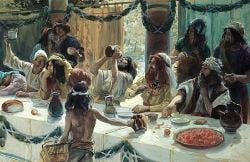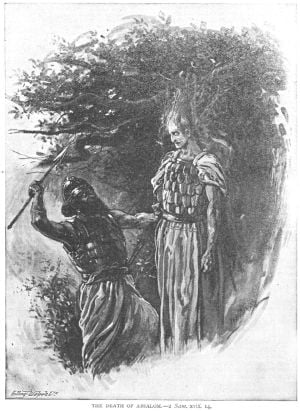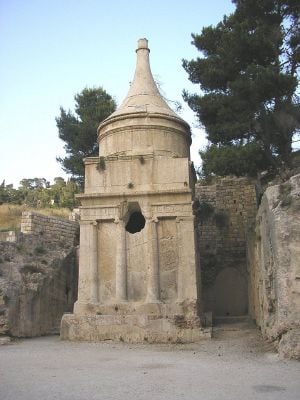Absalom
Absalom (אַבְשָׁלוֹם, Hebrew: Avšalom, "father of peace"), in the Bible, was the third son of King David and leader of a major rebellion which temporarily dethroned his father in the late eleventh century B.C.E.
Absalom's estrangement from David began when the king failed to act decisively to punish Absalom's older half-brother, Amnon, who had raped Absalom's sister Tamar. Two years later, Absalom took revenge by having Amnon murdered. Absalom lived for three years in exile under the protection of his grandfather, the king of Geshur, and was superficially reconciled with David two years after returning to Jerusalem. He soon grew in popularity and was deemed the most beautiful man in the kingdom.
A leader of obvious promise and charisma, Absalom used his growing base of support outside of Jerusalem to mount a revolt against David from the former capital of Hebron. He then succeeded in ousting the weakened king from Jerusalem and pursued him toward the east. However, following the intentionally unwise advice of a false counselor, Hushai, he failed to attack David when the fleeing king was vulnerable, allowing David time to cross the Jordan River, resupply, and choose a favorable battleground.
Absalom died when his long hair became entangled in an oak tree and he was slain by David's general, Joab. The prince was famously mourned by the king, who had hoped his son would survive the rebellion. Although he left no surviving sons, his daughter, Maacah, would marry David's grandson, King Rehoboam and thus become the foremother of the subsequent Davidic kings through the Babylonian exile. Absalom can thus also be considered as one of the ancestors of Jesus Christ, based on the genealogy provided in the first chapter of the Gospel of Matthew.
Biblical story
Born at Hebron while David, who ruled only over Judah, was still at war with the house of Saul, Absalom was David's third listed son. His mother was Maacah, the daughter of Talmai, king of Geshur.
The rape of Tamar
After David had unified the kingdom and settled his royal family in Jerusalem, Absalom faced a severe crisis. His sister Tamar had been raped by David's eldest son, Amnon, who was temporarily in love with her but came to hate her after he had defiled her.
Absalom comforted and protect the distraught Tamar, waiting two years to avenge her disgrace while the king seemingly took no action to punish the criminal. He then invited Amnon and several other princes to a feast at Baal Hazor near the border of Ephraim, during a sheep-shearing celebration. After Amnon had drunk his fill of wine, Absalom ordered his servants to murder him (2 Sam. 13).
Absalom took refuge with King Talmai of Geshur (see Joshua 12:5), his maternal grandfather. Although David "longed" for him, it would take three years for Absalom to return in safety to Jerusalem, largely through the influence of his older cousin Joab, commander-in-chief of the army. Back in the capital, Absalom lived in his own home but was still not admitted into the king's presence.
Reconciliation with David
During this period, he busied himself raising a family consisting of three sons and a daughter, the beautiful Tamar, named after Absalom’s sister. He developed a national reputation, and his good looks became legendary (2 Sam. 14). Yet, after two more years, Absalom still had not met face to face with his father, King David. Joab, reluctant to approach the king further on Absalom's behalf, refused to meet the prince. Absalom decided to take desperate measures and had Joab's fields set aflame, later declaring to him: "Why have I come from Geshur? It would be better for me if I were still there! Now then, I want to see the king's face, and if I am guilty of anything, let him put me to death."
This unorthodox diplomatic strategy proved effective, as Joab intervened again with the king and David finally received Absalom, greeting him with a kiss after the prince offered his obeisance.
Over the next four years, Absalom ingratiated him with the outlying tribes by meeting with travelers to the capital and sympathizing with their complaints, promising them justice, "If only I were appointed judge in the land" (2 Sam 15:4). After having established what he believed to be an adequate foundation for his plans, he asked the king for permission to travel to Hebron, David's former capital, in order to fulfill a religious vow there.
Absalom's revolt
At Hebron Absalom dispatched messengers to raise a revolt. "All Israel," meaning the northern tribes, and much of Judah rallied to his side, declaring "Absalom is king in Hebron!" Ahithophel, one of David's chief advisers, soon joined the rebellion, along with major elements of the army, leaving David protected mainly by mercenary troops and the loyal Joab. So effective was Absalom's strategy that the king decided to abandon Jerusalem, fleeing across the Kidron Valley toward the desert. Priests secretly loyal to David remained behind in Jerusalem, and their sons Jonathan and Ahimaaz served as his spies.
Absalom soon reached the capital and entered it without resistance. Already anointed, on the advice of Ahithophel, he publicly demonstrated his kingship by having sex with David's concubines on the palace rooftop "in the sight of all Israel" (2 Samuel 16).
The retreating David wisely took the precaution of instructing his adviser, Hushai, to infiltrate Absalom's court and subvert it. To that end, Hushai convinced the new king to ignore Ahithophel's advice to press his advantage. Informed by his spies of Absalom's plans, David used this critical opportunity to cross the Jordan and prepare for the upcoming conflict, receiving much needed aid from Gileadite and Ammonite allies.
The decisive battle was fought in a "wood of Ephraim." David had chosen his ground wisely, as Absalom's army was completely routed, and "the forest claimed more lives that day than the sword." Unwilling to kill his own son despite his treachery, the king ordered is generals to "be gentle with the young man Absalom for my sake." Absalom himself, sporting the long hair for which he was famous, found himself entangled helplessly by his locks in the boughs of an oak tree. Joab, being informed of the situation by one of his soldiers, did not hesitate to act. He thrust three spears through the Absalom's heart as he struggled in the branches. Joab's armor-bearers then moved in to finish the job.
Aftermath
The death of Absalom did not end the rebellion of the northern tribes who had rallied to his cause. Soon, a Benjaminite leader name Sheba, son of Bicri, emerged and revived the revolt under the slogan: "We have no share in David, no part in Jesse's son! Every man to his tent, O Israel!" (2 Sam. 20:1). Once again "all the men of Israel" deserted David to follow Sheba. Judah, however, remained mostly loyal to the king, who returned to Jerusalem, though not to glory, keeping his defiled concubines under guard, never visiting them, and treating them as widows.
Refusing to forgive Joab for killing Absalom, David placed Absalom's own general, Amasa, in charge of the army to battle Sheba's forces. The always decisive Joab, however, took the earliest opportunity to slay his rival, and then led the army to besiege Abel Beth Maacah—a town probably associated with Absalom's mother's family. There, a "wise woman" eventually persuaded the local population to turn against Sheba and deliver his head to Joab. Returning in victory to Jerusalem, Joab regained his position of commander-in-chief. He retained this job for the rest of David's life, but made the mistake of backing the usurper Adonijah as the old king lay dying. David would take his revenge against his erstwhile general from the grave, when the young King Solomon fulfilled David's death-bed command to have Joab assassinated shortly after Solomon's ascension.
Legacy
David had been overwhelmed with grief at his son's death and ordered a great heap of stones to be erected where Absalom fell. Another monument near Jerusalem was erected by Absalom himself in his lifetime to perpetuate his name (2 Sam. 18) because he had reportedly had no surviving male child. Neither of these monuments has survived, although a later tomb, the "Yad Avshalom," is named for him.
The Books of Chronicles report that Absalom had a daughter named for his mother, Maacah (or her country). Despite her status as the child of Judah's most notorious rebel, or perhaps because of it, King Rehoboam took her as his wife. He loved her, "more than any of his other wives and concubines," and she bore him four sons, including Abijah, the next king of Judah. Thus Absalom became the forefather, on their mother's side, of all of the succeeding kings of Judah until the Babylonian exile. Although rarely mentioned as such, this also makes him the forefather of the Davidic Messiah. In Christian tradition, he would also be one of the Davidic ancestors of Jesus Christ, as listed in the first chapter of the Gospel of Matthew.
David's mourning for Absalom has been the subject of numerous literary and artist works. One of William Faulkner's major novels, although related to the story only by analogy, took its name from David's cry upon learning of his son's death: Absalom, Absalom!
ReferencesISBN links support NWE through referral fees
- Dryden, John. Absalom and Achitophel. Whitefish, MT: Kessinger Publishing, 2004. ISBN 978-1419104534
- Faulkner, William. Absalom, Absalom! Random House; Reissue edition, 2002. ISBN 978-0375508721
- Kirsch, Jonathan. King David: The Real Life of the Man Who Ruled Israel. Ballantine, 2000. ISBN 0345432754
- Pinsky, Robert. The Life of David. Schocken, 2005. ISBN 0805242031
- Rosenberg, David. The Book of David: A New Story of the Spiritual Warrior and Leader Who Shaped Our Inner Consciousness. Harmony, 1997. ISBN 0517708000
Credits
New World Encyclopedia writers and editors rewrote and completed the Wikipedia article in accordance with New World Encyclopedia standards. This article abides by terms of the Creative Commons CC-by-sa 3.0 License (CC-by-sa), which may be used and disseminated with proper attribution. Credit is due under the terms of this license that can reference both the New World Encyclopedia contributors and the selfless volunteer contributors of the Wikimedia Foundation. To cite this article click here for a list of acceptable citing formats.The history of earlier contributions by wikipedians is accessible to researchers here:
The history of this article since it was imported to New World Encyclopedia:
Note: Some restrictions may apply to use of individual images which are separately licensed.



